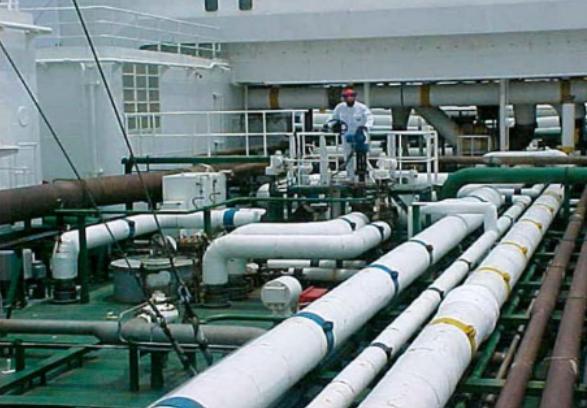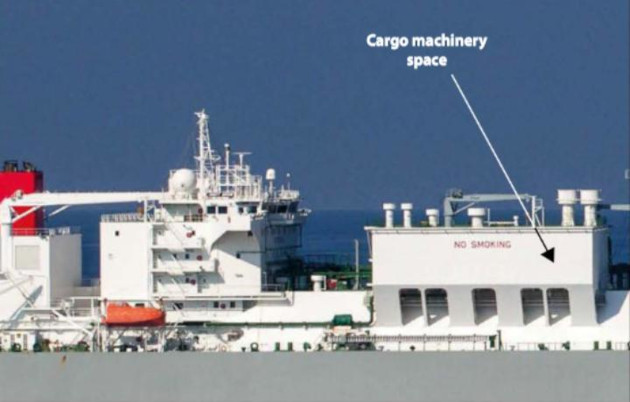Reference: SIGTTO “LNG Shipping Suggested Competency Standards”, Sections:
1 Have an awareness of the types of cargo related spaces:
- hold spaces;
- ballast tanks;
- pipe trunkings;
- cargo machinery spaces;
- cofferdams.
2 Know and understand the requirement for the operation and maintenance of cargo related spaces:
- dew point;
- oxygen content;
- cold spot inspections;
- ballast tank inspections.
Hold spaces (Moss)
The areas between the water ballast tanks, the double bottom tanks, underneath the cargo tank weather covers and the cargo tank are cal led the hold spaces.This space around the tank and inside the tank skirt area is kept as dry as possible and the atmosphere in the space is controlled and monitored. It is especially important that the hold spaces are monitored Terminal Operations for LNG or LPG Carrier after Arriving in Portduring cargo operations.
To avoid the possibility of the cargo tank shell buckling, the pressure of the cargo hold spaces should never exceed 0,05 bar (50 mbar) over pressure of the cargo tanks. Cargo hold pressure relief valves are fitted to avoid this occurrence.
Before LNG is loaded into the tanks, the hold spaces should be thoroughly dry to avoid any moisture penetration into the tank insulation.
There is a hold space heating and drying system to dry out these spaces, which removes moisture and prevents any dew forming, which should assist in the prevention of corrosion. If the relative humidity is kept below 50 % – 60 %, the corrosion rate is kept extremely low.
The hold spaces are fitted with a gas and liquid detection system, which will indicate/alarm in the CCR via the IAS. The hold spaces are normally kept under dry air, with an ability to introduce IG in the event of cargo vapour detection .
Prior to hold space inspection on Moss ships, the space must be aerated and then enclosed space entry procedures fully followed. The condition of the cargo tank insulation/spray shield must be monitored, paying attention to the equatorial support structure.
Ballast tanks
These are the tanks that hold ballast water after the ship has discharged her cargo. The weight of ballast water is calculated to obtain the desired draught, trim and propeller immersion for the ballast voyage to the loading port.
Ballast piping and valves are usually located/routed through a piping duct known as a “duct keel”.

Pipe trunkings. These are the pipe racks, or trunkways, along the deck of the LNG carrier that support:
- cargo lines;
- vapour lines;
- boil-off lines;
- fire main;
- electrical cabling;
- compressed air;
- nitrogen, etc.
Cargo machinery space
This is also known as the “compressor room” or “compressor house” and is where the compressors, Use of Vaporisers on Liquefied Natural Gas CarriersLNG vaporiser and heaters are located. On ships fitted with an LNG reliquefaction plant, this will also be located here.

While older ships may have steam driven compressors and equipment, modern ships will have electrically driven equipment and this is housed in an electric motor room, adjacent to the cargo machinery space and separated by a gas-tight bulkhead. Positive pressure ventilation must be provided for the electric motor room, with negative pressure ventilation for the cargo compressor area to ensure a positive pressure differential between the two spaces.
Cofferdam
This is the term for the space between two bulkheads. It is a Class requirement that all spaces around the cargo tanks are inspected once in every six month period. To meet this requirement the inner hull around a nominated cargo tank is inspected, as appropriate:
| Icon | Tank Type | Description |
|---|---|---|
 | Moss | From the hold space and liquid dome void spaces |
 | Membrane | From ballast tanks, cofferdams, whaleback (truck deck) spaces and the duct keel |
A ship specific program should be established so that all associated spaces are inspected at least once during the six month cycle.
Dew point. On Moss ships, dry air is introduced to the hold space through the IG filling line. The space is filled with dry air to prevent the formation of corrosive agents within the hold space. Using the ship’s dry air plant can reduce the dew point to less than minus 25 °C (-25 °C).
Oxygen content. If the hold space is inerted during shipboard operations, it will typically be to an O2 content of 3 % or less. When the space is to be inspected it must be gas freed and confirmed as containing 20,9 % O2 and with no trace gases prior to entry under enclosed space permit conditions.
Cold spot inspections. It is a Class requirement for granting the Certificate of Fitness, for ships carrying liquefied gases in bulk, that routine cold spot inspections are carried out and recorded in the LNG survey record book. The cold spotting inspections should coincide with a loaded condition passage and involves a visual inspection of any steelwork adjacent to the cargo tank. The position, extent and extreme temperature of any cold spots should be recorded, or any change or absence of the same where previously recorded. The records will be inspected by Class surveyors.
Ballast tank inspections
Typically, the following points should be included in the inspection and noted on the approved company specific form:
- condition of ballast tank sacrificial anodes;
- condition of ballast tank coatings;
- extent of corrosion, particularly under the suction strums and in way of striking plates;
- position and amount of any sediment in the ballast spaces;
- visible damage, fractures, etc. Particular attention should be paid to the external portion of the inner hull for evidence of fractures, particularly at the turn-of-bilge areas within the midships section of the ship;
- the condition of any associated equipment, i. e. signs of hydraulic valve leakage, sounding pipes, external condition of ballast lines/couplings, access ladders/rails, etc;
- where appropriate, ballast lines should be filled and the integrity of lines and associated valves visually checked.
On membrane ships, as the containment system is adjacent to the ballast tank, the surfaces must also be checked for “cold spots”.
The inspection of all such spaces exposes those involved to hazard, O2 levels must be monitored prior to and during all work associated with the above activities. A full risk assessment must be undertaken and safe working procedures put in place, i. e. permit to work (PTW), enclosed space entry procedures/documentation, toolbox talk.
